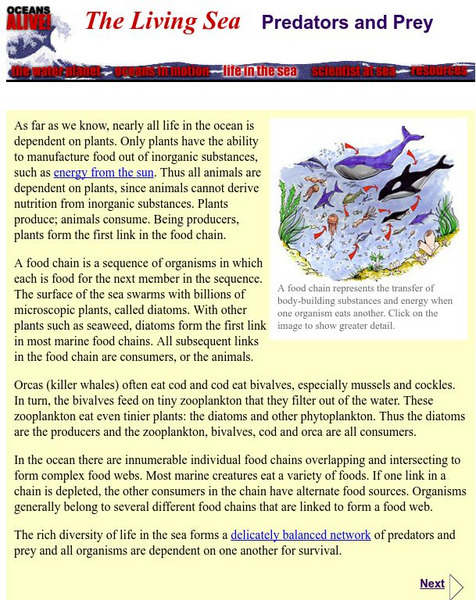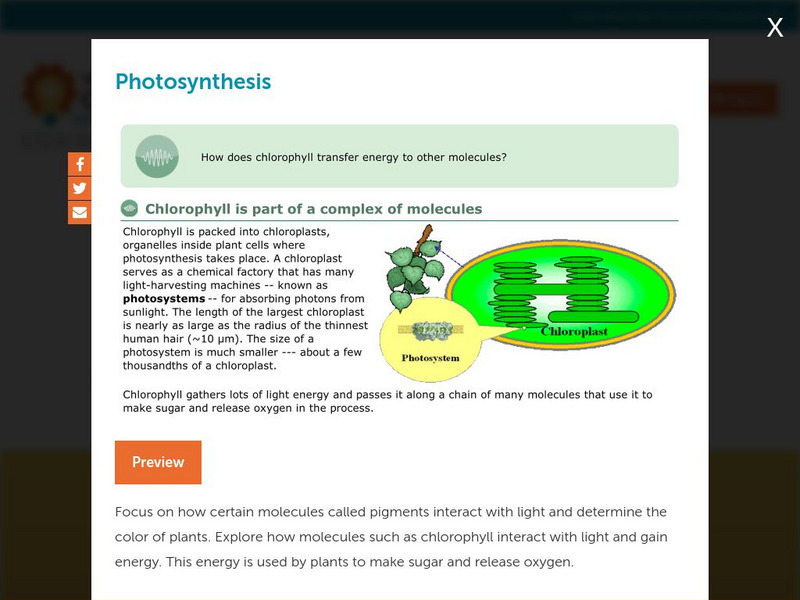Wisconsin Department of Natural Resources
Wisconsin Dept. Of Natural Res.: Leaves Changing Color
Scroll below the Fall Color Report on this site for information from the Wisconsin Department of Natural Resources that easily explains why and how leaves change color and why they fall. There are colorful illustrations and appropriate...
Science Made Simple
Science Made Simple: Why Leaves Change Color
This is a site that offers answers to some often hard to answer questions such as why do leaves change colors. Provides an easy to understand answer to the question along with a section that students can read on their own, a puzzle,...
NASA
Nasa: Illuminating Photosynthesis in the Arabian Sea
Article from NASA reports on research in Arabian Sea utilizing satellite data to determine effect of aerosols and cloud cover on annual pattern of incoming light available for photosynthesis.
Woods Hole Oceanographic Institution
Woods Hole Oceanography Institute: Photosynthesis vs. Chemosynthesis
Compare and contrast the energy generating processes of chemosynthesis and photosynthesis with this interactive resource.
Science Struck
Science Struck: A Helpful Guide to Understand the Photic Zone
The photic zone is the upper layer of the ocean where sunlight can penetrate and support photosynthesis. This article explains the characteristics of this zone, the food chain that exists there, the adaptations of the plants and animals,...
Educaplus (Jesús Peñas Cano)
Educaplus: Fotosintesis [In Spanish]
Observe the process of photosynthesis with this presentation.
PBS
Nh Pbs: Nature Works: Photosynthesis
This resource identifies the main parts of the photosynthesis process. Learn more about how sunlight plays in plant growth.
BBC
Bbc: Gcse Bitesize: Photosynthesis
This lesson focuses on photosynthesis including what it is, the word and symbol equations for photosynthesis, how it works, and how the extra glucose is used. It also offers links to a video and a test.
Science Struck
Science Struck: Examples of Chemistry in Everyday Life
Gives examples of chemical interactions occurring in the human body, in the world around us, in foods, and in products we use.
Science Struck
Science Struck: Difference Between Food Chain and Food Web
Explains the characteristics of food chains and food web; the different levels of producers, consumers, and decomposers; and the differences between food chains and food webs. Includes charts and a Venn diagram comparing the two.
Museum of Science
Museum of Science: The Living Sea: Predators and Prey
This Museum of Science page does an excellent job of explaining the importance of plants as producers in the sea. The food chain or food web has to start with the plants.
Science Struck
Science Struck: Understanding the Ocean Ecosystem
Describes the two organisms capable of photosynthesis in an ocean ecosystem, the different ocean zones and the plants and animals that live in them, some facts about the ocean, and the five oceans of the world.
BiologyWise
Biology Wise: Photosynthesis and Cellular Respiration
Explains the processes of photosynthesis and cellular respiration in plants. Discusses light-dependent and light-independent reactions in photosynthesis, and glycolysis and aerobic respiration in cellular respiration. The differences...
Texas A&M University
Tamu: Aggie Horticulture: School Gardens
Teachers and students interested in finding information on how to start a garden in their school will find this site very helpful. This site, sponsored by the Department of Horticulture Sciences at Texas A&M University, includes a...
BiologyWise
Biology Wise: Facts About Chloroplast
Explains how chloroplasts evolved into their present form, how photosynthesis takes place in them, where they are found in plants, physical characteristics, and other functions they perform.
BiologyWise
Biology Wise: An Overview of the Difference Between Nadh and Nadph
NADH and NADPH are enzymes involved in cellular processes. Explains how NADH participates in catabolic reactions where energy is released and NADPH is involved in anabolic reactions where energy is consumed. Their functions and chemical...
BiologyWise
Biology Wise: Chloroplast: Structure and Function
The structure and functions of chloroplasts are described in detail here.
Concord Consortium
Concord Consortium: Plants (Intermediate)
What do plants eat? This unit explores plants and how they make food. (Requires Java)
Concord Consortium
Concord Consortium: Plants
What do plants eat? This unit explores plants and how they make food. (Requires Java)
Concord Consortium
Concord Consortium: Photosynthesis
Focus on how certain molecules called pigments interact with light and determine the color of plants. Explore how molecules such as chlorophyll interact with light and gain energy. This energy is used by plants to make sugar and release...
Texas A&M University
Texas A&m University: Photosynthesis
Page provides background on photosynthetic process as well as factors affecting photosynthesis (page 24).
abcteach
Abcteach: Science: Plants
[Free Registration/Login Required] Generate comparison charts, crosswords, and journals for recording data on plants and plants processes. One can also find lesson plans and plant experiments, as well as flower and tree resources.
eSchool Today
E School Today: Introduction to Photosynthesis
Find out about the needs of plants to grow and live.
PBS
Nh Pbs: Nature Works: Ocean Zones
Discover more about the underocean environment at this site that surveys animals, environmental factors such as light and temperature, currents, animals, plants, and the like.







![Educaplus: Fotosintesis [In Spanish] Activity Educaplus: Fotosintesis [In Spanish] Activity](https://content.lessonplanet.com/knovation/original/369548-6636ed4ce023219de4b9b21d16c6187c.jpg?1661812330)









